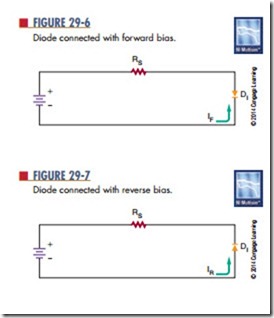Diode characteristics
Both germanium and silicon diodes can be damaged by excessive heat and excessive reverse voltage. Manufacturers specify the maximum forward current (iF max) that can be handled safely. They also specify the maximum safe reverse voltage (peak inverse voltage, or PiV). If the PIV is exceeded, a large reverse current flows, creating excess heat and damaging the diode.
At room temperature, the reverse current is small. As the temperature increases, the reverse current in- creases, interfering with proper operation of the diode.
In germanium diodes, the reverse current is higher than in silicon diodes, doubling with approximately every 10°C of increased temperature.
The diode symbol is shown in Figure 29-5. The P section is represented by an arrow, and the N section by a bar. Forward current flows from the N section to the P section (against the arrow). The N section is called the cathode, and the P section is called the anode. The cathode supplies and the anode collects the electrons.
Figure 29-6 shows a properly connected forward- biased diode. The negative terminal is connected to the cathode, and the positive terminal is connected to the anode. This setup conducts a forward current. A resistor (RS) is added in series to limit the forward current to a safe value.
Figure 29-7 shows a diode connected in reverse bias. The negative terminal is connected to the anode, and the positive terminal is connected to the cathode. In reverse bias, a small reverse current (IR) flows.
Questions
1. What problem can a reverse current create in a germanium or silicon diode?
2. Draw and label the schematic symbol for a diode.
3. Draw a circuit that includes a forward-biased diode.
4. Draw a circuit that includes a reverse-biased diode.
5. Why should a resistor be connected in series with a forward-biased diode?

